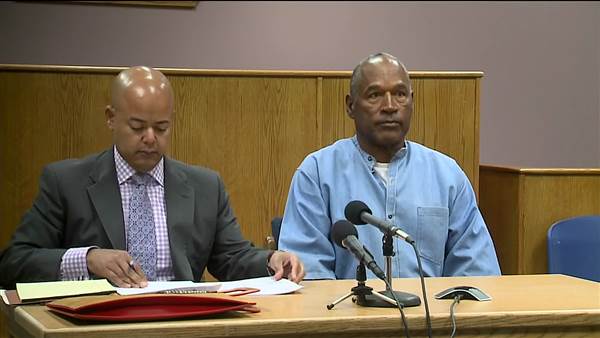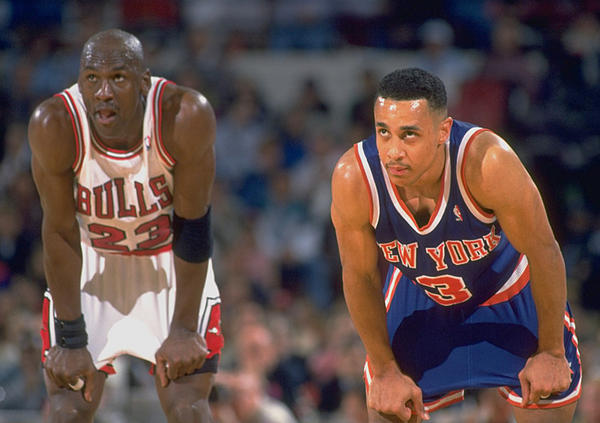
JOHN STARKS / CONTRIBUTOR

https://www.youtube.com/watch?v=fJRk_VCS8Mw&t=21s
People love to rank NBA eras, so let me be clear — my generation was the best. The way we played the game was incredible. Even if you were watching the game on TV, you could feel the passion on the court. People on the street come up to me all the time and say, “John, we miss that game. We miss the physicality!” Players were getting after it every night. Pro basketball used to be a contact sport.
But things change, and the game has evolved. Some of it is because of rules changes, but I honestly believe that just as much if not more is due to the emergence of a faster and more technically skilled game where versatility is an asset. Today you see more artistry — especially with ball movement — which is something I really appreciate and think fans should, too. The modern NBA fan wants to see that up-and-down pace — they want to see high-scoring games and I don’t blame them. TV ratings are up, the league’s reputation is soaring and in terms of worldwide attention, basketball’s profile is rising. Do I love the NBA of my era? Absolutely. But do I wish that style of play would make a comeback? No way. It’s all happening the way it should happen.
I still get nostalgic, though, for that tougher, more emotional style. Today, teams don’t have that anchor in the paint that most of them had back then (Patrick, Shaq, David Robinson, Hakeem) so everything is about ball movement. It was definitely tougher back then — it was like night and day compared to the modern game — but the skill level in today’s NBA is incredible. In 1990, I played in the World Basketball League, which a lot of people don’t remember. It was this up-and-down style, and I averaged 20-some points a game. It was a wild style and I loved it. It was similar to the way Golden State plays today. Moving the ball and shooting from anywhere on the court.
With all that being said, I don’t want people to forget just how good the NBA was back when I was playing and how hard we competed with one another. On that note, here are the five toughest defensive assignments of my 14-year career.
Mitch Richmond
Mitch was a big guard — 6′ 5” and about 220. (I was about 6′ 2″, 185.) He could do it on both ends of the court. He was a solid defender and took pride in it. More than that, though, he could outmuscle me at times when he had the ball in his hands, and he knew it. He could post me up and he could take me off the dribble on occasion. I think what made him particularly tough was his tenacity on the offensive end. I came into the league with Mitch in Golden State, and I watched him dominate his rookie year. He even had a lot of success against Michael that season, which turned a lot of heads.
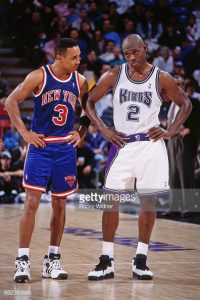
When I had to guard him, there wasn’t one specific way to stop him. Once he started to drive and he put that 220 on me, I was just bouncing off of him for the most part. I tried to deny him the ball as much as possible, and to crowd him a little bit more than a normal player just so he couldn’t get a big head of steam going.
Against him, my quickness was my weapon. I had to move my feet. That was the main thing. From the two spot, I was a pretty short guy considering that the average size for a two guard back then was like 6′ 5”. My average opponent outweighed me by about 15–20 lbs. I used my quickness and tried to be as aggressive as possible on the defensive end. When they caught the ball I either got up on them or backed off of them depending on whether they were a good shooter.
Mitch dominated the league for a few years at his position, because of his combination of power and finesse, as well as his refined post-up game. He was a top five guard before he got old — like we all do, eventually.
Reggie Miller
Reggie is different from every other guy on this list. Reggie was extremely active whether he had the ball or away from it, and guarding him was probably the toughest assignment in the league because of that. He was the quintessential off-the-ball guy. The way he could find cutting lanes and picks to get open — it was almost scientific.
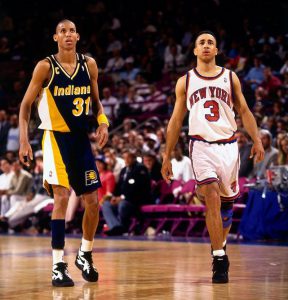
Reggie was 6′ 7″, about 185 pounds, so he wasn’t a big, strong guy who made his dough overpowering guards. He needed others to free him up — and he had the Davis boys, Dale and Antonio, setting monster screens for him. He wasn’t a guy who was going to beat you off the dribble, even though he’d catch you with it from time to time. Once he caught the ball on the arc and you weren’t right there, it was over. An open three for him was basically a layup.
But he wasn’t just a catch-and-shoot guy. He also might take one or two dribbles and go for the bank shot from 17 feet. He wasn’t a guy you could relax on. You couldn’t take a play off with him. A lot of defending Reggie was just about focus. When I was on him, it felt like everyone else on the court was playing a different game than me and him.
Remember Reggie’s famous eight-points-in-nine-seconds sequence? Sure you do. But do you remember who was guarding Reggie at that time of the game?
That game was supposed to be over. And he did something that superstars do, he made plays at the end of the game. He was special in that way. He liked being the villain. Most guys don’t like that role — especially in the modern NBA — but Reggie embraced it, even fed off of it. I think that’s what made him special when he came to the Garden.
I learned a lot from him about how to come off of pick-and-rolls, how to free yourself up. That’s one of the secrets to longevity in the NBA, now or back then — you steal certain moves from other players. I stole one of his baseline moves, one of the ways that he used to free himself up to get an open jumper — the way he would go down to the baseline and turn his back toward you, then give you a little shimmy move, faking like he was going right and then come off left You knew it was coming, and you’d find yourself jumping the other way. It was amazing how many times it worked when I started to adopt it. I also stole that stop-and-go move he’d do, where he would fake hard, hit your body and freeze you and then come off the pick.
Something I don’t think people understand about three-point defense is that when a guy in this league is going, he’s going. You can close out and do everything the scouting report tells you to do, but if a guy like Reggie — or Steph Curry — is getting clean releases and gets hot, there’s only one thing you can do: pray.
Steve Smith
Steve Smith would have fared well in the current era, but he really dominated in ours when he got going. He was 6′ 8″ and could stroke it. He could take you off the dribble. He had this little half-move he used to do, he would have his back to you and do a fake like he was going spin back right, but he would really spin left. At his size he could post you up, too. He had a pretty well-rounded game. For me, that combination was always the toughest to defend. I could get up underneath him a little more than I could most guys ’cause he was 6′ 8″ — you couldn’t really back off him too much because he was such a three-point threat. I tried to keep my body on him, that was the main thing. Like Reggie, I didn’t want to let him get going. If you were physical with him you could disrupt him. I wanted to make sure he felt my presence. (You couldn’t get away with a lot of that today with the hand-check rule.)
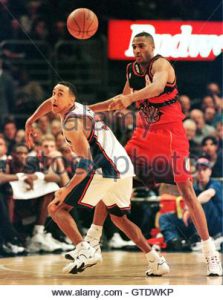
SPORT NBA
With Mitch, I knew that he was going to post me up most of the time — it was just a huge matchup advantage for him. Steve was a good post-up player, but he preferred to play a little bit more on the perimeter. I just had to make sure to move my feet well. Once he pulled up, I wasn’t blocking his shot. The one time I did manage to block his shot was when he was down in the post. He turned around to shoot the ball and I jumped early and got my hand on the ball. It was such a shock that I remember the one time I did it!
Defense in the NBA is about instincts. But there’s more to it than that. Instincts come from preparation — knowing the player, knowing his tendencies and his patterns. We used scouting reports like religious texts. This guy likes to go left when you close out on him, or, This guy likes to go right when you close out on him. Does he does take one or two dribbles before pulling up? Does he go all the way to the basket when he goes left or right? With Steve, he would go one to two dribbles on you when he was going left. Or if he saw a lane he would go to the basket and try to dunk on you.
Clyde Drexler
Clyde was 6′ 7″ and 210, so yeah, he was another one of those huge dudes I used to get tasked with chasing around. Clyde could fly, too, which was an awesome sight. I don’t think people remember just how big he was — as big as or bigger than any guy on this list. He could post you up, he could take you off the dribble. He wasn’t a great outside shooter, but he was a very consistent jump shooter — he knew his spots and he’d do the work to get to them. He wasn’t like Reggie, who just oozed range, but he was capable of making three-point shots if he needed to.
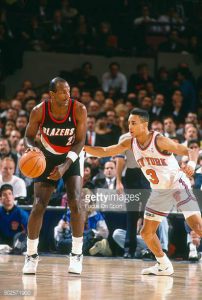
Clyde could flat out leap. He was a guy who could jump over the top of you, but I did learn one slight weakness in his game that I tried to exploit: He wasn’t strong going to his left. Clyde liked to pump-fake a lot, get the defender off balance and go to the hole, or pull up for a jumper. As a player, I always relied on the scouting reports I got, and some of them I’ll just never forget. Clyde’s report was one of those: “He goes left on occasion but he rarely goes left and pulls up.” So when I would close out on him, I would try to force him left into a jumper. Stuff like that gave me an edge where I really needed one. (You know, ’cause he had 25 lbs on me.)
Looking back, I would never say that I shut people down on D, but I tried to contain them. Clyde would try to take me down in the post — that’s where he was strong. He would get going that way too. So I tried to make up for my lack of size by being physical in the post and fronting him, relying on my help on the backside.
No matter what the matchup is, the last thing you wanna do is let skilled players run free. Once they get hot, it’s over. So I wanted to body them and remind them I was there. You always gotta keep your body on guys — that was our mentality on those Knicks teams. Put a body on somebody! That’s what Riley preached during his time in New York. You want opponents to understand you’re going to be there all night long. They’re not going to have the freedom to do what they want to do. Even with the bigger guys like Clyde, that went a long way toward disrupting their rhythm.
Michael Jordan
This might sound crazy — and every time I explain it to someone, they’re shocked — but Michael was the easiest to guard on this list.
I know, I know. I’m not saying I stopped him or anything. But let me explain.
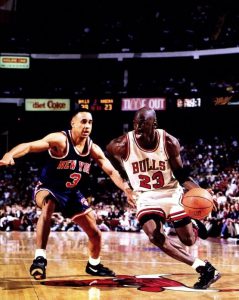
Reggie moved a lot. You had to chase his ass all over the floor and get pounded into picks. The thing about Michael is that he wasn’t going to run you around a bunch of picks. He was just gonna get the ball and line you up. He was probably one of the only guys in the league who had no weaknesses in his game. You’d get the scouting report and it would basically say, “Good luck.” The only weakness I observed was that he wasn’t a great three-point shooter. He could make them when he needed, though, and over the years he got even better at it.
I’m not exaggerating that much when I say that MJ could jump out the gym. And he had those big hands that could palm the ball. He could create space for himself. He was special in that way. When Mike was out there, he was trying to kill your spirit. He took everything personally and when he stepped out on the court he felt that he had something to prove every single time. That was just him, whether it was me or whoever else guarding him. His mentality wasn’t just to score a lot of points. He wanted to crush your soul.
As a player you fear that mentality, but you appreciate it because you’ve got a little bit of that in you, too, knowing that you’re going against the best night in and night out. After guarding Jordan, I can say that I played against the greatest. Even if I failed a lot of the time, I can live with that.











